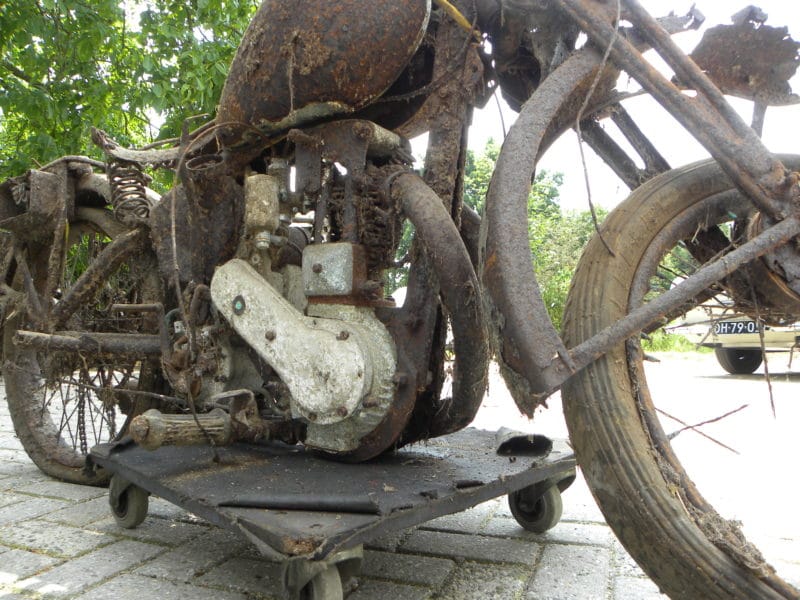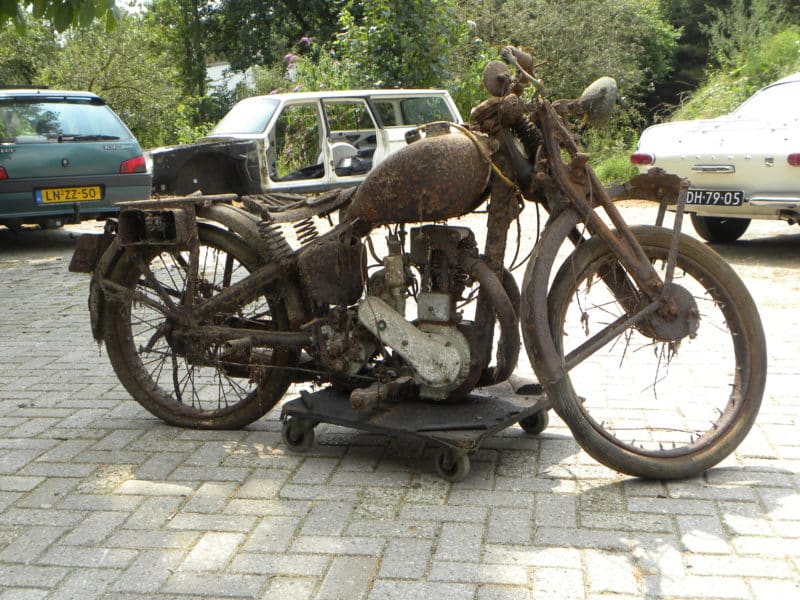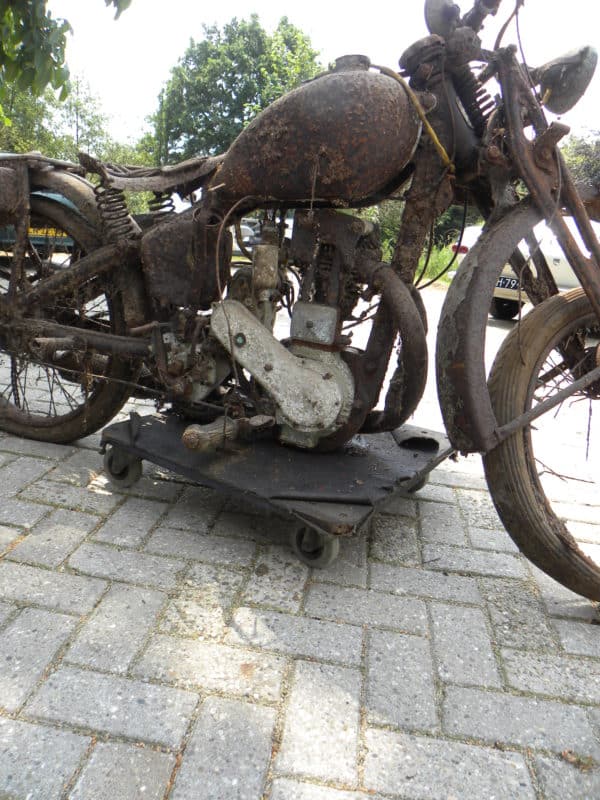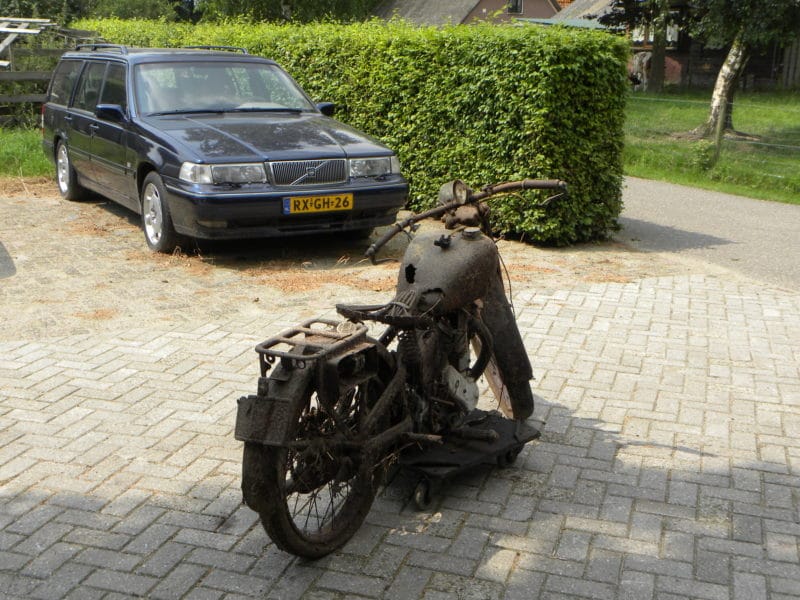Anyone who dreams about Dutch immigrants in southern Spain or Portugal is wrong. We are talking about the Netherlands, even the edge of the Randstad. And the Netherlands is a country where there are now many abandoned farms. Long-abandoned farms…
A barn find
In a shed stood a Batavus Whippet that had been used as a cross moped, a set of terminal plate mopeds and a lot of completely or half buried junk plus an old trailer. A piece of motorcycle stuck out behind the clutter around it. That motorcycle was dug out. But what was left was very interesting. Because we have never seen a stranger DKW.
The authentic looking type plate states that it is a 250 cc machine
The 'looks' of the DKW are those of a DKW 300 from the first half of the 200s or those of a DKW SB 300 from the second half of that decade. The tank of the 1928 most closely resembles the one on this barn find. In 43.000, DKW was the largest motorcycle manufacturer in the world with "emissions of XNUMX units". And scored on the circuits the SS 250 and 350 cc with 'Ladepumpe' high eyes while making so much engine noise that nowadays a rain of complaints from local residents would immediately follow. However, this barn find is convincingly a four-stroke machine. The power source and transmission turned out to be Ariel's after investigation. The English single-cylinder OHV (with open valve control and therefore from before 1938) and gearbox are mounted in the bicycle section in such a way that apparently this was not done on a rainy pre-war Saturday morning. For example, the secondary transmission in this find is on the other side than the one DKW had come up with. That work also looks well thought out. Some polishing and cleaning showed that the engine number M 1230 is stamped on the crankcase. According to the books, this indicates a 'lightweight (250 cc) OHV from 1930 and that fits nicely with the year of construction of the DKW bicycle part.
An incomplete history
The new owner has been looking for the relatives of the ex-owner who died at the age of 91. His son said that the machine in its current DKW-Ariel version was already driven by his father before the war. The motorcycle has never had a 'Dutch' registration, but has always been registered in Gelderland. Unfortunately, the Gelderland registers from that time have not been preserved. 1956 Was the last year of the provincial plates, after that we switched nationally to the still existing system. The type plate appears to be original. Or not? Even before the Second World War, owning a set of battle letters was not only reserved for factories.
It was not a budget bike
But then again: in the thirties a 250 cc overhead valve block from England plus the accompanying box was not a bad thing. Such a block-box combination must have cost serious money at the time, because the whole stuff was fairly recent or new at the time. An Ariel with a DKW block is more obvious when it comes to 'keeping what we have running'.
The option to simply dispose of the wreckage as scrap iron would be the most obvious option for calm-thinking people.
But the best thing is to completely restore the hybrid.
All the more so because there are rumors that the folks at DKW, the two-stroke masters from Zschopau, were once figuring out whether valved DKWs might be an option. According to those rumours, DKW would have done some searching and shopping before the war to make a few four-stroke DKW test models. Just say: to see how that tasted. And what if this find from the outskirts of Ede were such a test bike?
The finder and his father are both technically talented, 'Pa' Teus Voskuil, is a car restorer of the sort where customers bring cars that have to be perfected without reservation.
That is why the approach of son and father is now: First find out what the dear son has actually found. That search alone makes the find worthwhile. But somewhere in the background there is clearly already a second plan: the DKW-Ariel simply has to be put back in order. If you are a DKW expert: We'd love to hear from you.








great story again, yes make it roadworthy again and let the time continue.
nice shot of that front wheel.
regards
Beautiful, absolutely leave it that way, Whatever you do with it, it doesn't get any better than this.
Hans
To see what kind of screw thread is on it , I think more an Ariel block with Lucas ignition , remains a gamble .
By the way ariel means A lls R ammelt I n E en K eer Los think boj this one will not be stuck BUT nice like that, n fonst
As far as I know, DKW only sniffed the four-stroke engine at the end of its existence, purely to survive..
We're talking 1964-65… and then only in their auto branch.
The motorcycles were always, from start to finish, equipped with a small tent.